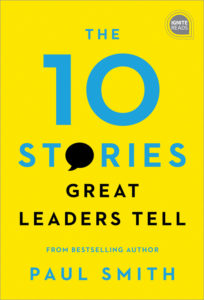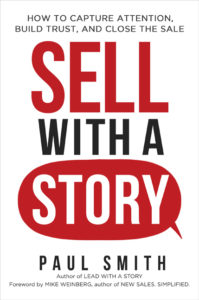Podcast (lead-with-a-story-podcast-series): Play in new window | Download | Embed
Subscribe: RSS
 Most company founding stories are boring.
Most company founding stories are boring.
And that’s a shame. Because nobody ever quit their job and risked everything to start a new business for a boring reason. But if you read the company website for most companies, their founding stories sound like this:
“Our founder started the company in 1936 in her basement with $500 and two employees. Today we have over twenty thousand employees, offices all over the world, and last year made the Fortune 500 list for the first time…”
Yawn.
I mean, sure, those are impressive numbers. But so what? Every single company on the Fortune 500 started small and got huge.
So, yes, your company is very successful now. But that’s not what a founding story is supposed to communicate. The founding story is about the founding of the company, not what it’s like today, and not even the 83-year journey to get where you are now.
Here’s a better way (from chapter 1 of The 10 Stories Great Leaders Tell):
To craft a proper founding story, you need to explain the visceral, human reason why the founder founded the company in the first place.
Ideally, what you’re looking for is that single moment in time where the founder decided they couldn’t stand to keep doing what they were doing one minute longer and struck out on their bold new plan.
You’re looking for a time like when Fred Smith got a ‘C’ on his term paper at Yale outlining his idea for an overnight delivery company but decided to start FedEx anyway. You’re looking for a moment like when Bill Gates decided to drop out of Harvard and start Microsoft.
Here’s what a story built around a moment like that sounds like:
In 1990, Gary Erickson went out for a 175-mile bike ride around San Francisco with a friend. And as most bikers do, he’d brought half a dozen energy bars with him to eat when he got hungry.
About 125 miles in they took a break. Gary had already eaten five of his six bars but was still famished. He looked at the sixth one in his hand and thought, No way. I can’t do one more. I’d rather starve than eat another one of these!
Those early energy bars were hard and sticky and would sit in your stomach like a rock.
As he was finishing up the ride on an empty stomach, Gary was thinking to himself that he ran a bakery in town, and everything they made tasted great. So, why did these energy bars—that just about every cyclist and runner were eating—have to be a bitter pill you had to swallow just to perform?
That’s when Gary had an epiphany. He turned to his friend and said, “You know what. I can make a better energy bar than this!”
The next day he called his mom and started working on a formula in her kitchen. After six months of trial and error they’d found just the right recipe—with whole oats and real fruit, but no oil, butter, or added sugar.
He’d already named his bakery after a woman in his family. So, when it came time to give the new product a name, he thought he should name it after his father, Clifford. So, he did. And that’s when the CLIF Bar was born.
Tips to craft your founding story:
- If the founder’s still alive, ask for an interview.
- If not, ask someone else who knows the original story.
- You’re looking for the pivotal moment that changed everything, like Gary’s epiphany a mile 125 of his bike ride.
- Don’t be satisfied with a vague answer about building a business or even saving the world. Find out what that moment was for your founder and craft a story around it.
- Ask questions as if you were an investigative journalist.
- Then keep asking questions until you find yourself wanting to quit your job and start your own damn company. That’s how you’ll know you’ve got the story right.
Click these links to subscribe to this podcast on iTunes or Stitcher, or Podbean.
Source: The 10 Stories Great Leaders Tell, by Paul Smith
—
 Paul Smith is one of the world’s leading experts on business storytelling. He’s a keynote speaker, storytelling coach, and bestselling author.
Paul Smith is one of the world’s leading experts on business storytelling. He’s a keynote speaker, storytelling coach, and bestselling author.
Connect with him via email here. Follow him on Facebook, LinkedIn, and Twitter.
Sign up for his newsletter here to get one new story a week delivered to your inbox.
 |
 |
 |
 |
 |

